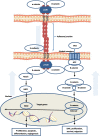Current advances in understanding the molecular profile of hereditary diffuse gastric cancer and its clinical implications
- PMID: 36869400
- PMCID: PMC9985294
- DOI: 10.1186/s13046-023-02622-3
Current advances in understanding the molecular profile of hereditary diffuse gastric cancer and its clinical implications
Abstract
Hereditary diffuse gastric cancer (HDGC) is an autosomal dominant cancer syndrome attributed to germline CDH1 mutations that carries a high risk for early onset DGC. HDGC raises a significant health issue due to its high penetrance and mortality unless diagnosed early. The definitive treatment is to undergo prophylactic total gastrectomy which is associated with significant morbidity., highlighting the urgent need for alternative treatment methods. However, there is limited literature examining potential therapeutic strategies building on emerging insights into the molecular basis of progressive lesions in the context of HDGC. The aim of this review is to summarise the current understanding of HDGC in the context of CDH1 pathogenic variants followed by a review of the proposed mechanisms for progression. In addition, we discuss the development of novel therapeutic approaches and highlight pertinent areas for further research. A literature search was therefore performed for relevant studies examining CDH1 germline variants, second-hit mechanisms of CDH1, pathogenesis of HDGC and potential therapeutic strategies in databases, including PubMed, ScienceDirect and Scopus. Germline mutations are mostly truncating CDH1 variants affecting extracellular domains of E-cadherin, generally due to frameshift, single nucleotide variants or splice site mutations. A second somatic hit of CDH1 most commonly occurs via promoter methylation as shown in 3 studies, but studies are limited with a small sample size. The multi-focal development of indolent lesions in HDGC provide a unique opportunity to understand genetic events that drive the transition to the invasive phenotype. To date, a few signalling pathways have been shown to facilitate the progression of HDGC, including Notch and Wnt. In in-vitro studies, the ability to inhibit Notch signalling was lost in cells transfected with mutant forms of E-cadherin, and increased Notch-1 activity correlated with apoptosis resistance. Furthermore, in patient samples, overexpression of Wnt-2 was associated with cytoplasmic and nuclear β-catenin accumulation and increased metastatic potential. As loss-of-function mutations are challenging to target therapeutically, these findings pave the way towards a synthetic lethal approach in CDH1-deficient cells with some promising results in-vitro. In future, if we could better understand the molecular vulnerabilities in HDGC, there may be opportunities to offer alternative treatment pathways to avoid gastrectomy.
Keywords: CDH1 pathogenic variant; Hereditary diffuse gastric cancer; Second-hit mechanism; Signet ring carcinoma; Synthetic lethality.
© 2023. The Author(s).
Conflict of interest statement
The authors declare that they have no competing interests.
Figures
Similar articles
-
CDH1 and hereditary diffuse gastric cancer: a narrative review.Chin Clin Oncol. 2023 Jun;12(3):25. doi: 10.21037/cco-23-36. Epub 2023 Jun 5. Chin Clin Oncol. 2023. PMID: 37303221 Review.
-
Diffuse Gastric and Lobular Breast Cancer Syndrome.2002 Nov 4 [updated 2024 Oct 10]. In: Adam MP, Feldman J, Mirzaa GM, Pagon RA, Wallace SE, Amemiya A, editors. GeneReviews® [Internet]. Seattle (WA): University of Washington, Seattle; 1993–2025. 2002 Nov 4 [updated 2024 Oct 10]. In: Adam MP, Feldman J, Mirzaa GM, Pagon RA, Wallace SE, Amemiya A, editors. GeneReviews® [Internet]. Seattle (WA): University of Washington, Seattle; 1993–2025. PMID: 20301318 Free Books & Documents. Review.
-
Associations of CDH1 germline variant location and cancer phenotype in families with hereditary diffuse gastric cancer (HDGC).J Med Genet. 2019 Jun;56(6):370-379. doi: 10.1136/jmedgenet-2018-105361. Epub 2019 Feb 11. J Med Genet. 2019. PMID: 30745422 Free PMC article.
-
Transcriptomic profiling and quantitative high-throughput (qHTS) drug screening of CDH1 deficient hereditary diffuse gastric cancer (HDGC) cells identify treatment leads for familial gastric cancer.J Transl Med. 2017 May 1;15(1):92. doi: 10.1186/s12967-017-1197-5. J Transl Med. 2017. PMID: 28460635 Free PMC article.
-
Cancer predisposition and germline CTNNA1 variants.Eur J Med Genet. 2021 Oct;64(10):104316. doi: 10.1016/j.ejmg.2021.104316. Epub 2021 Aug 21. Eur J Med Genet. 2021. PMID: 34425242
Cited by
-
Exosome-mediated communication between gastric cancer cells and macrophages: implications for tumor microenvironment.Front Immunol. 2024 Feb 22;15:1327281. doi: 10.3389/fimmu.2024.1327281. eCollection 2024. Front Immunol. 2024. PMID: 38455041 Free PMC article. Review.
-
Anti-tumor activity of all-trans retinoic acid in gastric-cancer: gene-networks and molecular mechanisms.J Exp Clin Cancer Res. 2023 Nov 11;42(1):298. doi: 10.1186/s13046-023-02869-w. J Exp Clin Cancer Res. 2023. PMID: 37951921 Free PMC article.
-
SMYD5 methylation of rpL40 links ribosomal output to gastric cancer.Nature. 2024 Aug;632(8025):656-663. doi: 10.1038/s41586-024-07718-0. Epub 2024 Jul 24. Nature. 2024. PMID: 39048817 Free PMC article.
-
Spatial Analysis of Hereditary Diffuse Gastric Cancer Reveals Indolent Phenotype of Signet Ring Cell Precursors.Mol Cancer Res. 2025 Aug 4;23(8):699-709. doi: 10.1158/1541-7786.MCR-24-1039. Mol Cancer Res. 2025. PMID: 40192595
-
Molecular targeted therapies for cutaneous squamous cell carcinoma: recent developments and clinical implications.EXCLI J. 2024 Feb 27;23:300-334. doi: 10.17179/excli2023-6489. eCollection 2024. EXCLI J. 2024. PMID: 38655092 Free PMC article. Review.
References
Publication types
MeSH terms
Substances
Grants and funding
LinkOut - more resources
Full Text Sources
Medical
Research Materials
Miscellaneous


